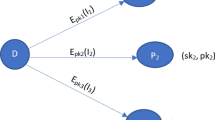Abstract
A perfect secret sharing scheme is a method of distributing shares of a secret among a set P of participants in such a way that only qualified subsets of P can reconstruct the secret from their shares and non-qualified subsets have absolutely no information on the value of the secret. In a secret sharing scheme, some participants could lie about the value of their shares in order to obtain some illicit benefit. Therefore, the security against cheating is an important issue in the implementation of secret sharing schemes. Two new secret sharing schemes in which cheaters are detected with high probability are presented in this paper. The first one has information rate equal to 1/2 and can be implemented not only in threshold structures, but in a more general family of access structures. We prove that the information rate of this scheme is almost optimal among all schemes with the same security requirements. The second scheme we propose is a threshold scheme in which cheaters are detected with high probability even if they know the secret. The information rate is in this case 1/3 In both schemes, the probability of cheating successfully is a fixed value that is determined by the size of the secret.
Similar content being viewed by others
References
M. Ben-Or and T. Rabin, Verifiable secret sharing and multiparty protocols with honest majority, Proc. 21st ACM Symposium on Theory of Computing, (1989) pp. 73-85.
G.R. Blakley, Safeguarding cryptographic keys, AFIPS Conference Proceedings, Vol. 48 (1979) pp. 313-317.
C. Blundo, A. De Santis, L. Gargano and U. Vaccaro, On the Information Rate of Secret Sharing Schemes, Advances in Cryptology CRYPTO'92 (E.F. Brickell, ed.) Lecture Notes in Computer Science, Springer-Verlag, Berlin, Vol. 740 (1993) pp. 148-167.
C. Blundo, A. De Santis, D.R. Stinson and U. Vaccaro, Graph Decompositions and Secret Sharing Schemes, J. Cryptology, Vol. 8 (1995) pp. 39-64.
E.F. Brickell, Some ideal secret sharing schemes, J. Combin. Math. and Combin. Comput., Vol. 9 (1989) pp. 105-113.
E. F. Brickell and D. M. Davenport, On the Classification of Ideal Secret Sharing Schemes, J. Cryptology, Vol. 4 (1991) pp. 123-134.
E.F. Brickell and D.R. Stinson, The detection of cheaters in threshold schemes, SIAM J. Disc. Math., Vol. 4 (1991) pp. 502-510.
R. M. Capocelli, A. De Santis, L. Gargano and U. Vaccaro, On the Size of Shares of Secret Sharing Schemes, J. Cryptology, Vol. 6 (1993) pp. 157-168.
M. Carpentieri, A perfect threshold secret sharing scheme to identify cheaters, Designs, Codes and Cryptography, Vol. 5 (1995) pp. 183-187.
M. Carpentieri, A. De Santis and U. Vaccaro, Size of shares and probability of cheating in threshold schemes, Advances in Cryptology, EUROCRYPT'93 (T. Helleseth, ed.) Lecture Notes in Computer Science, Springer-Verlag, Berlin, Vol. 765 (1994) pp. 118-125.
W.A. Jackson and K.M. Martin, Geometric Secret Sharing Schemes and Their Duals, Designs, Codes and Cryptography, Vol. 4 (1994) pp. 83-95.
E.D. Karnin, J.W. Greene and M.E. Hellman, On secret sharing systems, IEEE Transactions on Information Theory, Vol. 29 (1983) pp. 35-41.
W. Ogata and K. Kurosawa, Optimum Secret Sharing Scheme Secure against Cheating, Advances in Cryptology, EUROCRYPT'96(U. Maurer, ed.), Lecture Notes in Computer Science, Springer-Verlag, Berlin, Vol. 1070 (1996) pp. 200-211.
J. Rifà-Coma, How to avoid cheaters succeeding in the key sharing scheme, Designs, Codes and Cryptography, Vol. 3 (1993) pp. 221-228.
A. Shamir, How to share a secret, Commun. of the ACM, Vol. 22 (1979) pp. 612-613.
G.J. Simmons, How to (really) share a secret, Advances in Cryptology-CRYPTO'88 (S. Goldwasser, ed.), Lecture Notes in Computer Science, Springer-Verlag, Berlin, Vol. 403 (1989) pp. 390-448.
G.J. Simmons, An introduction to shared secret and/or shared control schemes and their applications, Contemporary Cryptology: The Science of Information Integrity (G.J. Simmons, ed.), Piscataway, N.J., IEEE Press, (1992) pp. 441-497.
D.R. Stinson, An explication of secret sharing schemes, Designs, Codes and Cryptography, Vol. 2 (1992) pp. 357-390.
M. Tompa and H. Woll, How to share a secret with cheaters, J. Cryptology, Vol. 1 (1988) pp. 133-139.
Author information
Authors and Affiliations
Rights and permissions
About this article
Cite this article
Padro, C., Sáez, G. & Villar, J.L. Detection of Cheaters in Vector Space Secret Sharing Schemes. Designs, Codes and Cryptography 16, 75–85 (1999). https://doi.org/10.1023/A:1008378426278
Issue Date:
DOI: https://doi.org/10.1023/A:1008378426278




